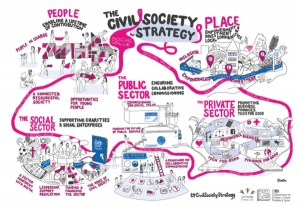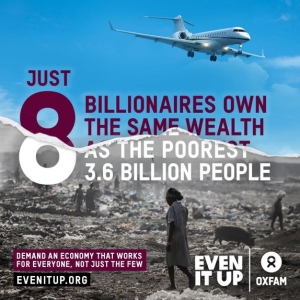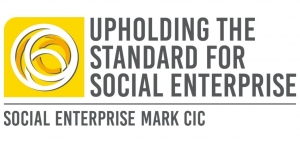Blurring the lines? Responding to the Civil Society Strategy
 The new Civil Society Strategy explicitly sets the direction of government, by widening the strategy of the traditional third sector to include the private sector agenda.
The new Civil Society Strategy explicitly sets the direction of government, by widening the strategy of the traditional third sector to include the private sector agenda.
It has been going in this direction for years of course – the advent of Big Society Capital, Social Investment, Social Impact Bonds have often been more concerned with social value creation than legal form. Is there anything wrong with this? It seems on the face of it, a ‘no brainer’. Why would you bother about the type of organisation when it’s creating loads of social value?
At Social Enterprise Mark CIC, we are often accused of being obsessed with form over function and of being pedantic about definitions. Interestingly, the definition of Civil Society within the strategy document – “we define civil society not by organisational form, but in terms of activity, defined by purpose (what it is for) and control (who is in charge)” – is in perfect alignment with our own criteria. In a nutshell, we look at the social mission, value and objectives of an organisation. We also look at the power relationship; through requiring an asset lock and independence, and by assessing the way that shareholders (if there are any) behave in distributing profits and controlling the company.
The strategy then goes on to say:
“Businesses are changing, to pursue social as well as economic purpose. The state is helping public service employees take control of their service through creating mutuals, reforming commissioning to support local and non-profit providers, and localising power.
All of this is ‘civil society’ – not a sector, but a range of independent activity aimed at achieving social value… we use the term ‘civil society’ in this hybrid sense, and ‘civil society organisations’ may be charities, public service mutuals, or businesses with a primary social purpose. To describe the ‘core’ of civil society we refer to ‘voluntary, community, and social enterprise organisations’, or simply ‘the social sector.”
Crucially here they talk about businesses with a ‘primary social purpose’. This does not address the issue of where power sits/who is in charge. For us this is a core principle and must not be undermined, as the balance of power is crucial in the way that a company is run and who it’s really for – i.e. whose social purpose and what is happening to the profits. For example, the much-criticised Virgin Care has a social mission to provide health and social care, and I’m sure that they can prove that they are creating social value in many ways. However, the ultimate control of this company is in the hands of the shareholders who want a return for their investment, which means that ultimately it is not the patient at the centre of the company, it is the shareholder. Even if a social enterprise is created that is majority owned by Virgin Care, it is still ultimately owned and controlled by a parent company that puts profit before social value. This is why we test independence as part of our assessment.
Later on in the document, under the Business Chapter, the strategy states:
“Our leading businesses increasingly put social and environmental responsibility at the heart of what they do. It is key to their strategies for long-term, sustainable value, including how they manage risk, and how they sustain public and investor trust in their brands and business models. Alongside this, a new generation of businesses now go further and commit themselves explicitly to social and environmental purposes or missions, alongside profit, in their goods, services and how they operate.”
 If this is the case, why do we have increasing social marginalisation and wealth disparity, as shown in a 2017 Oxfam report, which showed that just 8 wealthy individuals owned the same wealth as the world’s poorest 3.6 billion people. Just recently, we have also seen new evidence that the average pay of a FTSE 100 CEO is a 151:1 ratio to employees, which further demonstrates the wealth gap.
If this is the case, why do we have increasing social marginalisation and wealth disparity, as shown in a 2017 Oxfam report, which showed that just 8 wealthy individuals owned the same wealth as the world’s poorest 3.6 billion people. Just recently, we have also seen new evidence that the average pay of a FTSE 100 CEO is a 151:1 ratio to employees, which further demonstrates the wealth gap.
I do not mean to be dismissive about the motivations of all business, but at the same time we must not be naïve. Much of this stuff is tick in the box CSR and is not addressing the root of the problem; i.e. that there is a clear conflict of interest between being a shareholder owned and controlled business dedicated to maximising wealth, and the conditions that the business is creating for its workers and the communities that it interacts with. Can the government prove their statement above or do they take it at face value from the businesses telling them this is the case?
To be fair to the strategy, it does acknowledge that we are different as the ‘social sector’, but it is confusing that a lot of the document is not actually about the social sector at all and does not really analyse the challenges put forward in this case. I dare say, it’s far more palatable to say that social impact investment is being used to create social value, without questioning whether the social value being created is getting to the heart of the issue. Plus, who is actually in control? Is it at the expense of the marginalised?
We need a root and branch analysis of why we are creating a more unequal society and how current business practice is contributing to this. Are CEOs themselves dedicated to the creation of social value or is it a side-line in the CSR department? I was interested to read recently that a Democratic Senator (potential Presidential candidate) Elizabeth Warren in the US is proposing an Accountable Capitalism Act, which would lead to more wealth redistribution and power to workers by giving more power to stakeholders. This is the sort of fundamental change we need.
Over the last year, corporate profits have soared while average wages for Americans haven’t budged. It’s been the same sad story for decades. Today I’m introducing a new bill to help return to the time when American companies & workers did well together: https://t.co/9isNoIyzoW
— Elizabeth Warren (@SenWarren) August 15, 2018
There are lots of business people out there with great social motivations (such as those mentioned in the strategy), but until we challenge the current business model we will not get to the root of the issue, inequality will continue increasing.





